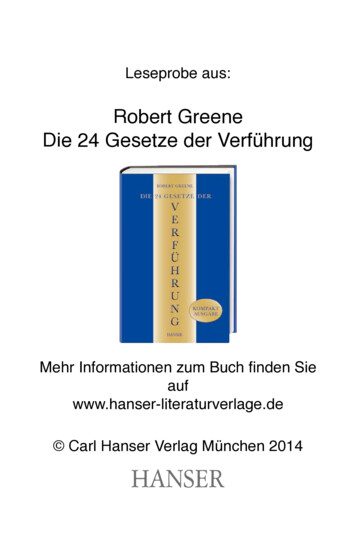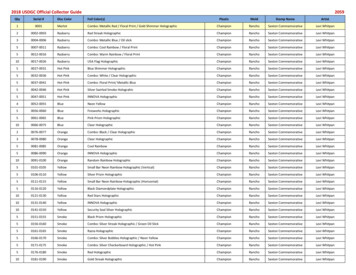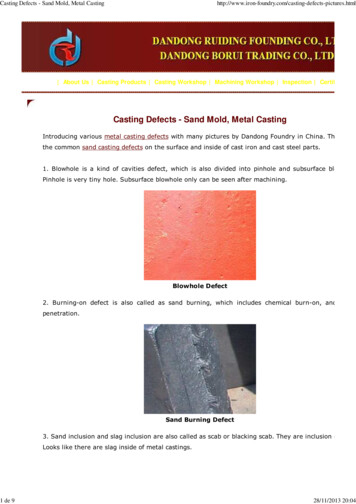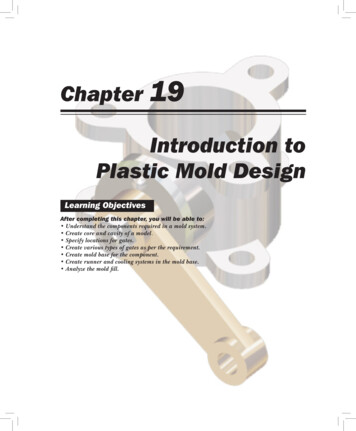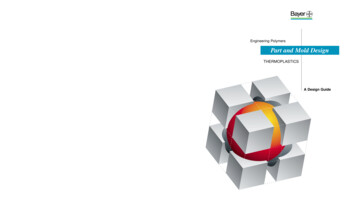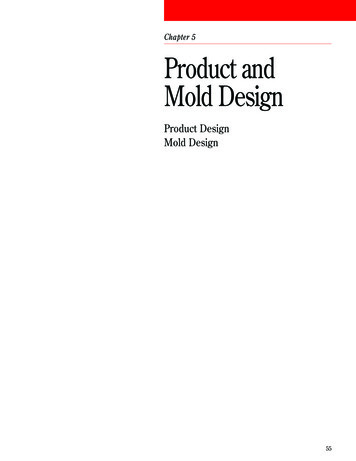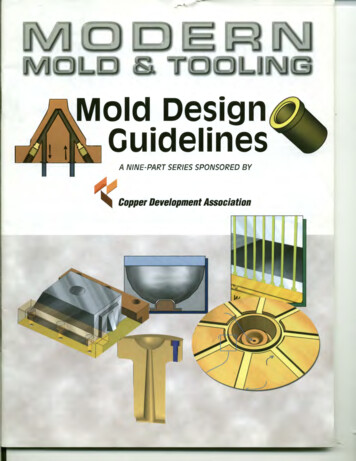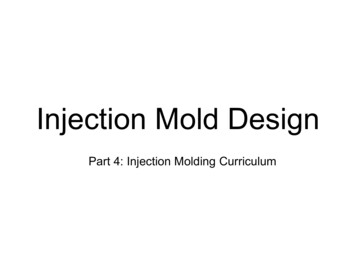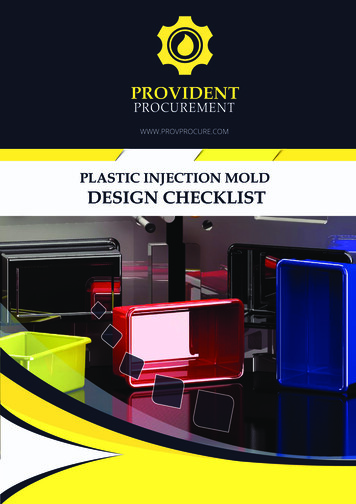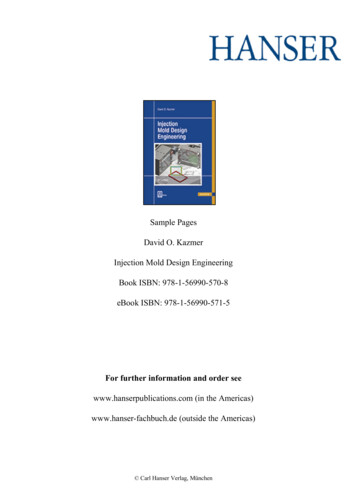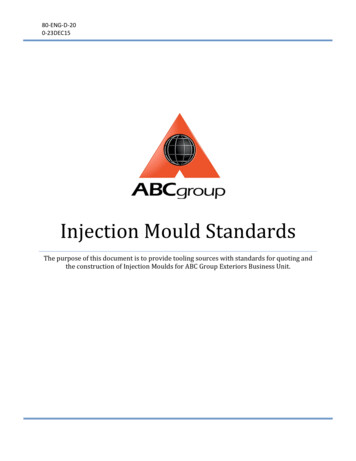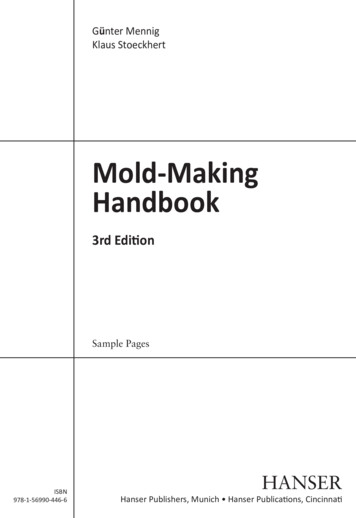
Transcription
Günter MennigKlaus StoeckhertMold-MakingHandbook3rd EdiƟonSample PagesISBN978-1-56990-446-6HANSERHanser Publishers, Munich Hanser PublicaƟons, CincinnaƟ
1581 Molds for Various Processing Methods 1.6 Rotational and Slush MoldsO. Wandres, R. Hentrich1.6.1 Process DescriptionFor the economic manufacture of seamless hollow articles made of plastic materials,the well-known procedures for blow molding and rotational molding can be used. Inthe origins of rotational molding, PVC or plastisols were used for the manufacture.Since “industrialization” of rotational molding in the 1950s, PE is the most widelyused processed material. PE is available in different densities and qualities, dryblended and compounded, ultraviolet-(UV)stabilized, electrically conductive, andphosphorescent. Other common materials are PVC, as well as PP, PA 6, PA 12, andPC. All of the RAL colors are feasible and even colors that imitate natural colorsare possible (e.g., stone, terracotta, etc.).The plastic material is mostly powdery. The dosed material is then inserted into theone- or multi-part mold. With the given part size and surface geometry, the amountof the plastic material determines the wall thickness of the hollow part. The filledand closed rotational mold (using clamping elements) is attached to the mold carriers, which are attached to the machine and drive elements.The most important characteristic is that the molds should rotate slowly around twoaxes at right angles to each other. This rotation takes place during the melt processand during the cooling process. After melting the plastic material, in a circulatingair oven (up to 350 C), the mold and product are cooled in a cooling station usinga water-air mixture or using cold air.The cycle time for the manufacture of a rotation molded product can be betweenfive to forty minutes, depending on various factors. Important influencing factorsare the type and size of the molds, machine performance, material choice, and wallthickness.1.6.2 Strength of a Rotomolded PartWhere in other plastic molding processes the outer contour of products is thinnerin some spots of the wall, the outer contour and radii of rotomolded products isthicker. Therefore, rotomolded products are very stiff. To increase the stiffnessof a rotomolded part, the easiest solution is to increase the weight and the wallthickness.
1.6 Rotational and Slush MoldsBesides the possibility to fill the plastic hollow room with PUR foam, PE foam canbe rotated into the mold as a second layer. A precise dosage of the material mixis necessary for this application (e.g., plastic powders from two materials withdifferent melting point). Therefore, a solid plastic skin is rotated first, followedby activation of the propellant-coated material of the second material (due to heatinduction), which then starts the foaming process. Another possibility is to insertthe propellant-coated material into the mold after rotation of the first plastic material layer. This can either be done using a manually operable filling opening, orby using a so-called “drop box”. This is a well-insulated container that is attachedto the outside of the mold and opens (at a desired time) a passage to the mold toinsert the “second shot”.Increased stability can be achieved through stiffness ribs or through targeted integration of tie points between the individual walls of the plastic product.1.6.3 Mold RequirementsDuring production as described above, rotational molds are exposed to many heating/cooling cycles. Typically, molds are heated to a minimum of 300 C and then cooledto ambient temperature (in each production cycle).These extreme temperature changes require not only the selection of the propermold but also, more importantly, a suitable design. In order to heat/cool the moldwith a minimum amount of energy, molds must be made as thin-walled as possibleand of a good heat-conducting material. Furthermore, the mold closures and themounting of the mold in the carrier must be designed so that they are fast and safein handling. It is most important that the leakage between the mold and the closurebetween the cavities (in multi-cavity molds) is reduced to an absolute minimum.Plastic leaks cause problems if they occur during production: the product thicknesscan be reduced and the plastic material can bake onto the outside of the hot mold.This burnt crust is difficult to remove and forms heat insulation, thus affecting theheat transfer through the mold wall. This can lead to different wall thicknesses ofthe plastic products. Furthermore, excessive flash builds up, which increases thefinishing costs.The surface quality and the shape of the mold cavity are transferred to the surfaceof the molded part. The shape of the article, the position of the possible undercut,and the surface quality, possibly with grained texture, will determine both thechoice of the correct molding material and the most suitable production process.Also, the different requirements for processing PE, PP, X-PE, PA, PC, and PVC (e.g.,corrosion problems that can occur through hydrogen chloride when manufacturingPVC) should be taken into account in the mold design.159
1601 Molds for Various Processing Methods1.6.4 Nomenclature of Rotational MoldsThe design of a rotational mold can be very diverse due to the general simplicity ofthese molds. Besides the single cavity mold (in which one product is manufacturedin one mold), there are also double or multi-cavity molds (in which two or moreproducts are manufactured in one mold and are mechanically separated) and combination molds (in which different products can be manufactured in a convertiblerotational mold). Figure 1.174 shows such a combination mold.This cast aluminum rotational mold can be modified using inserts so that eithera BBQ-Donut Half (Figure 1.175) with steps of invert or a half with motor andumbrella holder can be molded. The mold consists of 10 mold shells.Figure 1.174 BBQ-Donut moldFigure 1.175 BBQ-Donut mold
1.6 Rotational and Slush MoldsFigure 1.175 shows an assembled finished product (floating grill island – “BBQDonut ”). Both donut halves are manufactured in a modified combination mold.The rotational molded halves are made of PE and the dimensions are each4,000 2,000 1,200 mm.A single mold is a mold that is manufactured for only one product. If the demand ishigher than the output of a mold, identical molds can be produced. For the productionof large quantities, the so-called spider concept (multiple cavities are assembled toa frame) is recommended. Opening and closing of the assembled single molds isdone in one step and leads to significant time savings in handling.The construction of a rotational mold can be done in two parts (out of two moldshells) or depending on the complexity, in 3, 4, or 5 parts (Figure 1.174).How a mold is parted mostly depends on the demoldability of the plastic materialto be molded. This means that the mold has to be parted so that the removal of theshells off the products or the removal of the rotomolded plastic part out of the shellis done without causing damage. More decision-making criteria for the choice ofthe mold separation (e.g., optical and aesthetic requirements, general handling ofthe mold halves, etc.) can demand additional molded parts.1.6.5 Types of MoldsMolds that are needed for rotational production can be manufactured from different thermally conductive materials (where every design has its advantages anddisadvantages). The choice of the best suitable rotational mold is based on technicalcriteria (size, complexity, precision, surface structure, planned quantities, etc.) andeconomic factors like costs and production time.Molds from aluminum (aluminum casting and CNC-milled) or sheet steel are usedtoday for rotational molds. Electroplated molding has established itself for specialrotational molds for PVC plastisols. There are also a couple of other materials thatcan be used in prototype production.1.6.5.1 Prototype Rotational MoldsDue to the high temperature loads when producing rotomolded plastic parts, it isalmost impossible to use cheap prototype molds. A rotational mold has to have acertain thermal conductivity and has to constantly withstand changes in heatingand cooling.In the construction of prototypes, molds are used where the mold shells are manufactured in the metal spraying procedure. This is only possible for easy and flatcontours due to the metal spraying procedure.161
1621 Molds for Various Processing MethodsFigure 1.176 Prototype mold with carbon fiber molded shellsThe sprayed metal is comparatively porous, which leads to a defective surface qualityof the plastic product. In addition, the metal can only withstand the constant temperature change to a certain degree; it gets porous after a while and tends to crack.An alternative in prototype molding is the use of carbon fiber shells, which aremanufactured in an autoclave. The advantage of this application is that there arealmost no restrictions for mold design. The disadvantages are the high productioncosts and limited lifetime.Figure 1.176 shows a carbon fiber prototype mold for a 400-liter fuel tank with asimplified frame and screwed form flanges. The attachment of required fixtures likea fuel-level sensor, threaded fittings, inserts, etc. enables the rotation of prototypesin production-based design.1.6.5.2 Sheet Steel Rotational MoldsEspecially for high volume products (storage tanks) and for article contours with alow level of difficulty, molds from sheet steel are used. The wall thickness is mostlybetween 1.5 and 4 mm. Different sheet steels are welded or soldered. After a heattreatment for a stress reduction, the mold fit surfaces have to be refinished for bettersealing. The weld and solder lines have to be polished and reground. The quality ofthe surfaces is dependent on the skills of the tinsmith.A sheet steel rotational mold for the manufacture of an inspection chamber (diameter1,000 mm, height 2,200 mm) is shown in Figure 1.177. Before opening of the moldshells, the eight rotating steps, which are located in the contrary to the demoldingdirection, have to be withdrawn using a hinge system.
1.6 Rotational and Slush MoldsFigure 1.177 Sheet Steel Mold1.6.5.3 Aluminum Rotational MoldsThese molds can be made from CNC-milled or casted aluminum mold shells (a combination between both methods is possible as well). A mold made from a combinedcast aluminum and CNC-milled shells can be manufactured. In addition, a lot ofdifferent materials in a mold (aluminum with steel) can be used for the manufactureof mold shells.The production steps of both applications differ from each other significantly. Thecomplete construction of the mold shells and the design of the form separation andflanges have to be determined for the production of a machined aluminum mold.The manufacture of a mold begins mostly with the production of a positive model(per sample, drawing, or 3D data).CNC-machined molds are mostly used when the aluminum block to be machinedis very flat, when the production time is critical, or when the necessary tolerancesare very high.For an economical rotational production, it is necessary to machine the mold shellsto a certain wall thickness, which means to machine on both sides. This will ensurean equal and fast heat penetration of the mold wall.Figure 1.178 shows a CNC-machined aluminum rotational mold for a shaft cover(diameter 700 mm) with bent tubular steel frame and hand closures.The use of mold shells manufactured in an aluminum casting is advantageous forlarge and deep mold shells or for necessary follow-on molds. For the manufacture ofaluminum casting mold shells, the casting molds made from sand or sand/ceramicmolds have to be manufactured first. The aluminum casting process, shown inFigure 1.179, is done by hand.163
1641 Molds for Various Processing MethodsFigure 1.178 CNC-machined rotational moldFigure 1.179 Aluminum castingNegative molds are needed when manufacturing such casting molds. These correspond to the required mold shells and already have the necessary mold flangesand mold thickness (mostly between 7 and 12 mm).These negative molds are either produced according to the data or using a positive mold that is manufactured before. Structures added to the positive model, liketimber graining, terracotta, or stone structures, can be replicated in the castingmold and the aluminum casting.Depending on the type of aluminum casting process, there are small differences inthe manufacture of the casting mold. The most modern type of manufacturing such
1.6 Rotational and Slush MoldsFigure 1.180 Sand mold CNC processingcasting molds is the CNC milling of unmachined sand parts with CAM data. A verycomplex construction of the mold shells is needed (as seen in CNC-milled molds).The contours of the mold shells can be CNC milled using CAM data. Figure 1.180shows a 5-axis CNC processing of a sand casting mold for the manufacture of an aluminum casting rotational mold for a designer garden or lounge chair. A CNC-milledmold is manufactured in about five to six weeks, whereas the standard productiontime of a casting mold takes about eight to ten weeks. The size and complexity ofa mold are substantial factors in the production time.1.6.5.4 Electroplated MoldsIn electroplated molds, a model is molded to the smallest detail (see Section 4.3).The positive model, which corresponds to the finished article, is therefore the basisfor electroplated rotational molds and slush molds. The necessary finesse, such assurface quality, dimensional tolerances, mounting parts have to be determined.For example, it is possible in prosthesis manufacture to use rotational molds toget an exact impression of which the inner contour is an impression of the humanskin. This shows the precision of electroplated molds and the art to manufacturesufficient models made from resistant materials.The requirements of the models are strongly
The design of a rotational mold can be very diverse due to the general simplicity of these molds. Besides the single cavity mold (in which one product is manufactured in one mold), there are also double or multi-cavity molds (in which two or more products are manufactured in one mold and are mechanically separated) and com- bination molds (in which different products can be manufactured in a .File Size: 2MBPage Count: 20
